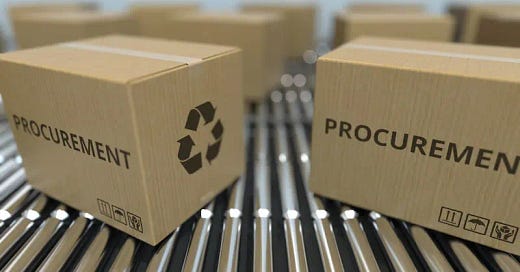👋 Hey, Kyle here! Welcome to The Influential Project Manager, a weekly newsletter covering the essentials of successful project leadership.
Today’s Overview:
As a project manager, one of your biggest responsibilities is making sure materials arrive where they’re needed, when they’re needed.
Getting materials to the site is just step one. You also need a system to receive, inspect, and stage them properly—so your people aren’t left scrambling.
This article gives you a proven procurement blueprint to eliminate gaps, prevent chaos, and keep your project running smoothly from start to finish.
🚚 Today’s issue is shipped to you by Krane!
Is managing your delivery schedule a never ending game of telephone?
When schedules are scattered across emails, texts, and individual planners, things fall apart fast. Missed shipments. Miscommunication. Downtime on site. It’s a problem we know all too well, and it’s costing teams valuable time and money.
It doesn’t have to be that way! With Krane’s Free Delivery Board, you can book, manage, and track deliveries all in one place. Visit Krane.com to get started today and experience seamless delivery management firsthand.
📘 The Procurement Playbook
Filed under: Project Management
Last week, we dove deep into buyout. This week, we tackle what comes next: procurement—the make-or-break phase of every project.
You’ve locked in trade partners, nailed down pricing, and secured contracts. Now comes the real challenge: aligning production demands with the supply chain so your crews have the materials, tools, and information they need to perform at the highest level.
And yet, here’s what I hear time and time again:
PM: “Our biggest bottleneck? Materials. Late deliveries. Supply chain.”
Me: “Can I see your procurement log?”
PM: “What’s that? We just rely on our trades to bring the material on time.”
This is a disaster waiting to happen.
Managing materials isn’t just the subcontractor’s job. It’s the GC’s job, too. If you’re not actively managing procurement, you’re rolling the dice on schedule, cost, and productivity.
Supply Chain vs. Procurement
Too many teams think procurement is just buying materials. It’s not.
Procurement is part of supply chain management—but it’s not the whole picture.
Procurement: The process of selecting, purchasing, and tracking materials.
Supply Chain Management: Everything—from planning, procurement, tracking, and logistics to ensuring materials arrive at the right place, at the right time.
A strong material management system ensures:
Long lead items are tracked on a procurement log—not buried in emails..
Just-in-time (JIT) deliveries keep the job moving without creating excess inventory waste.
Weekly procurement meetings between the PM, superintendent, and project engineers provide real-time visibility and rapid problem-solving.
Issues are solved early—not when a missing component halts production.
This is how you avoid chaos and run a predictable, high-performing project.
Understanding Supply & Demand
I learned early on as a young project manager that the master schedule isn’t a planning tool. It’s a legal tool.
Your P6 schedule or Gantt chart tells you what needs to be done and when—but it doesn’t tell you how it’s going to happen.
And that’s the real challenge.
Think of your demand as the scheduled work that needs to be completed—the deadlines, milestones, and critical path activities. Think of your supply as everything required to meet that demand—materials, tools, equipment, skilled labor, and the right information at the right time.
Supply chain failures happen when these two elements are misaligned.
Missed materials? Work stops.
Poor sequencing? Crews get stacked, causing delays.
Reactive ordering? You’re paying expedited shipping and rush fees just to keep up.
To prevent these problems, you need a structured approach to procurement:
A procurement log tracking every material from submittal to delivery—real-time visibility is non-negotiable.
A weekly work plan aligning supply with the field’s needs—so crews never wait for materials.
A daily procurement sync to identify and resolve issues before they snowball into delays.
Supply chain management isn’t a passive task—it’s an active discipline that determines the pace of your entire project.
8 Steps to Master Procurement & Supply Chain Management
Step 1 - Start with Design
Don’t design first and figure out procurement later. Plan the project, then design to match the execution strategy.
Define work packages early and ensure design supports them.
Identify long lead items and critical procurement needs upfront.
Incorporate prefabrication and kitting into the design phase to streamline field execution.
Step 2 - Build a Real Procurement Log
A proper procurement log should track both submittal approvals and fabrication/delivery timelines.
Work backward from the required-on-site date.
Include a supply chain buffer for unforeseen delays.
Flag late items in red and items approaching risk in yellow.
Break out materials by physical locations/zones to align with field execution.
Pro Tip: Use software like Krane to automate this process and provide real-time visibility into procurement status.
Step 3 - Manage the Information
Procurement isn’t just about materials—you need to secure the training, tools, and documentation that support installation.
Track & verify: Ensure complete shop drawings, submittal packages, and lift drawings (if necessary) are available.
Visual standards: Use pre-construction quality boards to establish clear expectations.
Installation support: Provide installation instructions, training, and real-time pricing approvals.
Information flow: Distribute RFIs and submittals promptly to prevent bottlenecks.
If you don’t have these things, you can’t effectively “make work ready.” You’ll end up with work that either can’t start or can’t finish.
Step 4 - Optimize Logistics
The reality? Materials are typically moved 9 times before they’re installed.
A proper logistics plan eliminates wasted movement:
Pre-plan material staging locations to minimize handling.
Use visual logistics boards to track deliveries and storage locations.
Coordinate with crane/forklift operators to ensure smooth material flow.
Keep them updated. These are living drawings and need to be accurate.
Step 5 - Use Just-in-Time Deliveries
Bringing in materials too early creates congestion, waste, and damage. Bringing them in too late? Delays and chaos.
Just-in-Time means delivering materials only when they’re needed.
Establish laydown yards for short-term storage.
Coordinate deliveries daily in foreman huddles.
Do not bring everything straight from the vendor to the jobsite.
Use software to align work activities with material arrival schedules.
Step 6 - Hold Weekly Procurement Meetings
Your superintendent’s job is to keep the bus moving. Your job as a PM is to keep the lights green.
The way you do this is by setting a weekly procurement and planning meeting where the project manager, superintendent, and project engineers:
Call vendors.
Do a page flip.
Map out the supply chain steps.
Review & update the procurement log or software.
Align material needs with the 3-12 week lookahead schedule.
Resolve supply chain issues before they impact production.
This isn’t a passive review—it’s an active problem-solving session.
Step 7 - Scheduling Deliveries
A disciplined delivery schedule eliminates wasted time and motion:
All deliveries are scheduled first come, first served (unless prioritizing a bottleneck).
Foreman huddles coordinate staging locations daily.
Marked staging areas prevent confusion and misplacement.
Site-wide visibility ensures every worker, hoist operator, and crane crew knows when and where materials arrive.
If workers and materials reach the right place at the right time, the project stays on track.
Step 8 - Manage Delays Before They Cost You
When a delay hits, you have options:
Start procurement earlier.
Work with trades to break up submittals for faster approvals.
Conduct in-person page flips with designers to expedite reviews.
Negotiate with vendors for alternative materials or expedited production.
Visit the fab shop to oversee progress.
Shift work sequencing to maintain momentum.
Even with the best systems, delays happen. Your job is to catch them early and adjust fast.
🔥 Your One-Week Jump Start
Target: When do you need your material to arrive so you have just enough materials, but not too much?
Set up a procurement log if you don’t already have one.
Assign a weekly procurement sync with your field and office teams.
Align material deliveries with your lookahead schedule.
Test a supply chain management tool like Krane to improve visibility.
With a real procurement system in place, your team will always have what they need—without the stops, restarts, delays, and cost overruns that kill project momentum.
The best project managers don’t leave procurement to chance.
They own it.
Until next week,
Kyle Nitchen

Whenever you're ready, there are 5 ways I can help you:
Get my first book! No Bullsh*t Project: A Project Manager’s Guide to Successful Project Leadership
Upgrade your scheduling software. Experience the future planning system for construction and real estate development. iPM subscribers get a 15% discount on the first year license.
Get my full toolbox (free). Access 30+ software and hardware tools I'm using today.
Learn Takt Planning. Elevate your skills as a scheduler, planner, and lean builder with the Takt Planning & Control online course. Use code "Influentialpmtakt" for 30% off.
Advertise in my newsletter. Put your brand in front of 5,900+ construction project managers, leaders, and execs. (Booked out 8 weeks)






